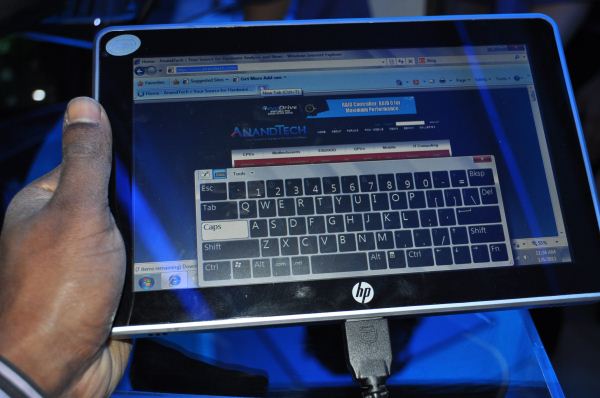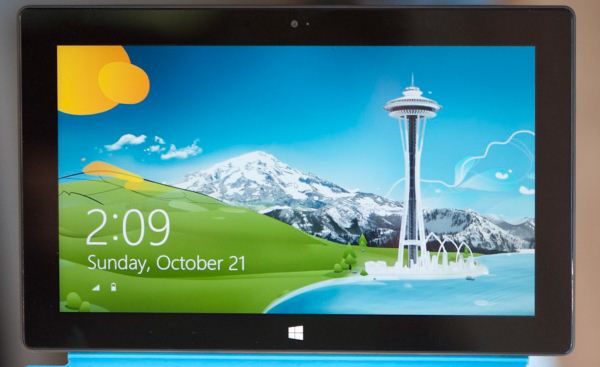The Windows RT Review
by Vivek Gowri & Anand Lal Shimpi on October 25, 2012 12:00 PM EST- Posted in
- Windows RT
- Operating Systems
- Microsoft
- Mobile
- Windows 8
- Tablets
Meet Windows RT
Microsoft’s first serious foray into tablets came just after the turn of the new millenium, with Bill Gates demonstrating the first tablet PC prototype onstage at Comdex in the autumn of 2000. From there, OEMs started releasing tablets based on Windows XP Tablet PC Edition in 2002, with a full range of pen-enabled slates and convertibles releasing over the next few years. In addition to oftentimes prohibitive cost, each had its own set of drawbacks. Convertibles tended to be quite bulky compared to their notebook counterparts (the ThinkPad X-series being a notable exception), while slates were rather difficult to use - a symptom of shoehorning a desktop operating system into a purely touch-centric form factor.
Fast forward a decade, to the beginning of 2010. After a number of conceptual non-starters in the tablet PC space - building tablet PC support into all editions of Windows Vista and 7 (other than Basic/Home Starter), the entire Origami class of devices - Microsoft’s touchscreen devices were floundering. The iPad had been announced to mixed reaction but an extremely high level of anticipation. Microsoft and HP countered with the Slate 500, an Atom-based device shown off at CES 2010 with solid state storage and Windows 7 in roughly the same form factor as Apple’s iPhone OS-based ARM tablet. With speculation pointing to a pricetag of just $549, the Slate appeared to be the most viable hope Microsoft had in trying to make mainstream headway with the tablet PC concept. But shortly after the iPad shipped in April 2010, rumors of the Slate’s demise started to circulate, and after a six month delay, the Slate 500 started shipping as an enterprise-only product in December of that year for $799. HP’s acquisition of Palm (RIP) definitely played a role in the sidelining of the Slate, but more importantly, it essentially spelled the end for the tablet PC. This was news that was perhaps known already, but the Slate saga officially pulled the plug on Microsoft’s original idea of what a tablet was.
The problem was two parts software, one part hardware. Microsoft had developed a very interesting touch-oriented user interface for its handhelds, so at least one part of the equation was relatively straightforward. The hardware issue came down to this: the iOS and Android tablets succeeding in the market ran off ARM system-on-chips, which resulted in slim, power-efficient tablets that had idle times stretching for days. At the time, there was just nothing in terms of x86 hardware that could compete with that in low-power device realm (Clover Trail and Haswell, of course, change this part of the story considerably). The other question? How to converge the touch-centric UI with the classic desktop environment that had been the corner of Windows dating all the way back to 95.
Meet Windows RT. It’s Microsoft’s first major foray into the modern tablet market, the shipping version of Windows-on-ARM, and it’s one of Microsoft’s most important product launches ever. Windows 8 shares the same touch-friendly user interface, but the ARM silicon makes RT an almost entirely tablet-centric operating system, the first for Microsoft. Combined with the focus on premium hardware experiences, this is Redmond’s most serious push to be competitive with the iOS and Androids of the world. How does it fare? Keep reading.












233 Comments
View All Comments
Sivar - Thursday, October 25, 2012 - link
Vivek and Anand, did you experience the problems described by guidryp?cappasay - Thursday, October 25, 2012 - link
I may be wrong but from what I understand, all the crashes are about third-party apps forcefully closing down. Not native apps, and not a full system crash or anything like that. Presumably that will get better over time, as devs actually learn the platform (updates are getting pushed out daily). Slowdowns seem to have occurred in other videos, only you have a bunch of apps open at the same time.daboochmeister - Thursday, October 25, 2012 - link
Not according to other reviews. E.g. Matt Burns at TechCrunch, whose review reads as completely honest and informed, found crashes in the Metro^h^h^h^hodern apps, at least once per app, including MS's. And he found the new IE10 to be less than great.http://techcrunch.com/2012/10/23/microsoft-surface...
Other reviews have said much the same.
The more high-profile the site, the more likely they are to give it a positive review. Hmm ...
VivekGowri - Thursday, October 25, 2012 - link
For the record, I had exactly one random shutdown, and that was when I was switching between two different camera applications at the same time. It seemed forgivable, and other than that I legitimately had no major bugs/crashes when I was testing. My VivoTab RT was really solid from a software standpoint, I don't know what to tell you guys.daboochmeister - Thursday, October 25, 2012 - link
Hmm. Maybe the Surface RT then. Different hardware.PeteH - Thursday, October 25, 2012 - link
Just because some people run into bugs it doesn't mean everyone will.p05esto - Thursday, October 25, 2012 - link
Lame response. Have you personally found all of these bugs and problems you are posting about? Do you have a Windows tablet in your hands? Just curious. In other words you are a fool, lol.TEAMSWITCHER - Thursday, October 25, 2012 - link
I too, am finding myself a bit suspicious of these reviews. I just cant get excited about Windows 8...in any form. There is something about it that disgusts me. Let me try to explain......Windows 8 was not designed to solve problems for me. It was designed to solve problems for Microsoft - namely competing against Apple mobile devices and Google's web services. The only major new functionality is a UI that can driven by a touch screen - (Compete with Apple) and the new Start Screen which is huge billboard directing witless users to Microsoft Web services (Compete with Google.) What does Windows 8 do for me, the guy who runs Windows 7 on a single 27" monitor with a Mouse and Keyboard?
Many people have told me that the tiles will be great. Really? I think that Gadgets are better, as I don't need to leave my desktop for a simple status update! That Metro apps will be great - you can run two apps side-by-side. I can run many apps side-by-side in Windows 7. I have read that touch screen laptops will transform the Windows experience. Not for me, I don't want to look through a hundred finger smudges to see my work.
The UI is definitely NOT gorgeous! The overuse of inky pastel colors makes me cringe every time I look at it. The removal of glass Windows and drop shadows make the desktop look old, flat, and boring. Please don't give me the "Simple and Elegant" argument - its not that!
I fear that all my ranting is for naught. No matter what I say, type, or do it won't matter. Windows 8 will be a resounding success because there is simply nothing else the PC OEMs have to sell. Microsoft will no doubt take the stage at this fall's BUILD conference and proclaim that they were right.
Sadly for me I cannot agree. Windows 8 is where I and Microsoft part ways...forever! I'd like to think that the break up was amiable, but that's not what happened.
Microsoft tried to F@#K me!
steven75 - Friday, November 2, 2012 - link
It's also almost like Vivek is completely unaware of the iWork suite that came out with the iPad back in 2010. And it's completely touch-optimized, not just a ported hack from OS X.code65536 - Thursday, October 25, 2012 - link
So how exactly is this no-third-party-desktop-apps thing enforced? Are they simply relying on the fact that people haven't recompiled EXEs from Intel to ARM (no enforcement)? Are they restricting the availability of the compiler (but they need a native compiler for folks like driver developers)? Are they whitelisting EXEs? Or must EXEs have a certain digital signature before they are allowed to run?